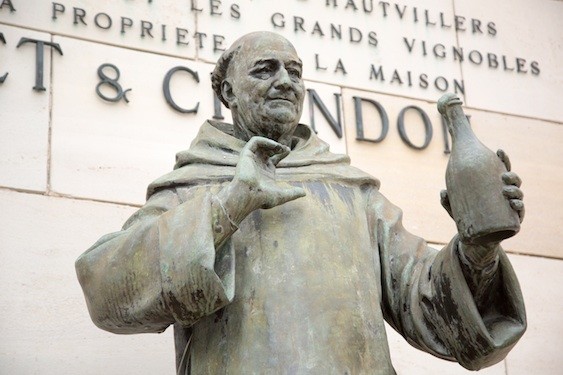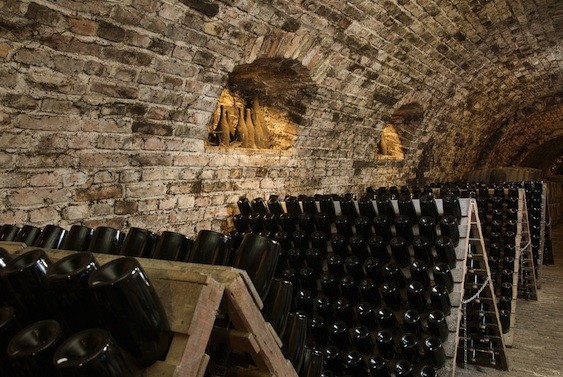According to legend, Dom Pérignon, a blind monk and cellar master at the Abbey of Hautvilliers outside the town of Épernay, exclaimed, “I have tasted the stars!” when he took his first sip of sparkling wine back in the 18th century.

It wasn’t stars Dom Perignon was tasting!
Well, I hate to break it to you, but there are no stars in that bottle of champagne (though read on for some fun facts about the bubbles!). The key to getting bubbles in champagne (and most high-end sparkling wines) is secondary fermentation. Remember that term.
You might know that fermentation is the process by which the yeasts that are present on grape skins (or specially cultured yeasts added by winemakers) convert the sugars in grape juice into ethanol (alcohol) and carbon dioxide. During your usual winemaking, that carbon dioxide is released from the fermentation tanks or barrels.
Without getting too technical about the proscribed timetables and things like that (it’s France – there are a lot of rules!), what champagne-makers do is let the wine complete first fermentation as usual to create the “base wine.” Here is where secondary fermentation comes in. When the base wine is made, they put it into bottles along with a sugary liquid that’s called the tirage and more yeast, and fasten on a tight bottle cap sort of like you’d see on a beer bottle. Because there’s more sugar and yeast in the mix now, the wine in the bottle undergoes secondary fermentation, and the carbon dioxide that’s produced this time around is stuck in the bottle under pressure. So the wine is essentially “carbonated,” but naturally.

Riddle me this – how many turns does it take to get the yeast out of the bottle?
I’ll get into the details of the champagne-making process in another post for those of you who are interested, but the short version of it is this: Generally, the bottles are left to age for over a year (and up to several for some wines!) All that stuff remains inside, including the exhausted yeast particles (called lees), until the wine is almost ready to be released on the market.
Then the bottles are “riddled,” or basically rotated periodically so that the lees gather in the neck of the bottle (Veuve Clicquot is said to have pioneered this process). The neck is then flash frozen so the lees solidify. The bottle cap is popped off, the solid materials shoot out (all this is called “disgorgement”), and a final little dose of wine and sugar called the dosage is added to the bottle to standardize the flavor to the house style. Finally, a special cork secured with a metal wire (called the muselet, or “muzzle”) is secured in place (thank the good old Dom Pérignon for this innovation). Voilà! That bottle of bubbly is ready.
What’s interesting about champagne is that secondary fermentation used to be regarded as a bit of a nuisance, and bubbly wine as ruined…that is, if the bottle containing it didn’t explode during secondary fermentation as a result of the increased pressure. Thanks to a few innovations that strengthened bottle glass, and the muselet to keep the cork in place, though, it wasn’t long before champagne became a much sought-after novelty.

What was once an accident has become a highly sought-after wine style.
So when winery folks say they make their sparkling wines using the méthode champenoise, they mean that they do so the same way champagne producers make their wines…i.e. as I’ve explained above.
Now here are another few scientific fun facts about champagne and its bubbles that you might not have known (but which should definitely impress your scientist friends).
The typical glass of champagne releases approximately 20 million bubbles (depending on how long you take to drink it!).
Each 750-milliliter bottle produces about 5 liters of carbon dioxide gas, and only about 20% of it is in the form of bubbles.
A bottle of champagne has about 5-6 atmospheres of pressure, or about 90 pounds per square inch, compared to about 30-35 psi in your average car tire.
The warmer your bottle, the faster the cork will pop out. Scientists have clocked cork speeds of up to 50 mph, so aim them away from people…unless they deserve a good pop.
That said, according to the American Academy of Ophthalmology, nearly 20% of serious eye injuries were caused by champagne corks in 2012, so be careful!

Watch where you point that thing!
Party trick: There’s also a fun little party trick you can do using your glass of champagne and a raisin. Just plop a raisin into the glass, and you’ll see it sink to the bottom, then rise to the top, then sink to the bottom again, then rise to the top and so on. Mesmerize your friends…as long as you can abstain from drinking, then explain that this phenomenon occurs because the bubbles seep into the wrinkles in the raisin’s skin, making it buoyant. When the raisin hits the surface of the liquid, those bubble pop and the raisin sinks back down to the bottom, where the process starts all over again. If only high-school physics class had been this interesting.

